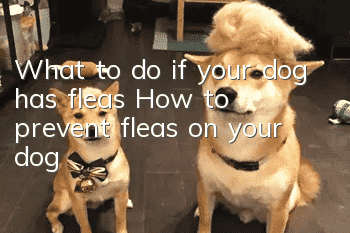What to do if your dog has fleas? How to prevent fleas on your dog?

Causes of flea parasitism
1. Insects of the order Flea are generally called fleas. Dog fleas, cat fleas, cock fleas, etc. can be seen on dogs. The flea body is 1-3 mm long, dark brown or yellowish brown. The body surface has a thick chitinous skin and piercing and sucking mouthparts. The head is small and closely connected with the chest. The antennae are short and thick, divided into 3 sections, lying flat in the antennal groove. 2. Fleas do not live on dogs for most of their lives. Because fleas are afraid of light, they often hide in the bedding of the kennel or in the cracks of the floor. They only infect the dog when they suck blood and lay eggs. 3. The eggs hatch into larvae. The larvae are cylindrical, legless, chewing mouthparts, 4 to 5 mm in length, and feed on dust, dirt or hemoglobin-containing feces of adult dogs. 4. When mature, the larvae spin the loose cocoon to attach to food debris and pupate. After about 5 days under optimal conditions, the adult worm escapes from the cocoon and looks for a host to feed and continue its developmental history. 5. Because fleas are highly mobile and have a wide range of host selectivity, they have become important spreaders of certain diseases.Symptoms of fleas
There are two main aspects of the harm of fleas to dogs: first, fleas can spread infectious diseases and parasitic diseases; second, fleas are strongly irritating to the skin, causing severe itching. If the dog scratches hard, it will cause skin damage, and the harassing dog will not be able to rest well, causing a decrease in appetite and weight loss. 1. The clinical symptom of this disease is mainly itching. The symptoms of sick dogs are scratching, rubbing and biting the coat, causing hair loss, hair breakage and abrasions. In severe cases, fluid may leak out from the skin abrasions, and even suppurative wounds may form. 2. Sometimes it can cause allergic reactions and form eczema. 3. If the dog is found to have the above symptoms, carefully examine the dog and find fleas or flea debris between the coat. Fleas tend to be most abundant near the head, buttocks, and tail tip. During the examination, comb the coat against the direction of hair growth and observe the hair roots and skin. If fleas or flea droppings are found, the diagnosis can be confirmed. 4. You can also use a piece of moist white paper, place it under the dog, and then comb the hair with a comb. The flea excrement will continue to fall on the white paper, and the diagnosis can be confirmed.Prevention and control measures for flea parasitism
1. To kill fleas on dogs, you can use 0.025% pyrethrum or 1% rotenone powder. These drugs are quick and safe to kill fleas. You can also apply 0.5% dermatophosphorus locally (to prevent contamination of food, feeding basins, drinking fountains, etc.). But flea eggs are highly resistant to pesticides and difficult to kill. It must be sprayed several times continuously, usually once a week for more than a month. 2. Thoroughly disinfect the floors and walls of the kennel, especially the dog's utensils, by spraying 0.5% malathion solution. 3. The bedding should be exposed to the sun frequently.Once fleas are found, the bedding should be burned, or fumigation with fluoromethanesulfonic acid should be used to control it. 4. Paying attention to dog body hygiene, bathing frequently, grooming frequently, and spending more time in the sun are effective ways to prevent fleas. 5. In addition, using an anti-flea collar is also a good idea. This kind of collar contains flea-killing medicine, which can repel or kill fleas when encountering them. But be aware that long-term use in some dogs can cause skin allergies. 6. Dogs with skin abrasions should be debrided, disinfected and prevented from infection. Dogs with severe itching can be injected with dexamethasone and diphenhydramine to relieve itching. 7. When performing preventive injections and necropsy of dogs, veterinary workers should spread rotten powder or DDT powder on shoes, condyle, outside of pants and cuffs to protect against fleas. Random articles
- There is a reason why dogs don’t wear shoes. For the sake of dogs, it is better to distinguish the situation and wear shoes.
- How much do you know about the difference between adult dog food and puppy food?
- What are the quickest ways to treat constipation in dogs? Do you know the causes of constipation in dogs?
- How to prevent fleas on dogs Prevention is far more effective than treatment
- Can I hit my dog if he bites something? Stick education can last for a while but not forever.
- What are the causes of calcium deficiency in dogs? Do you know these?
- What should you pay attention to when bathing a puppy? Owners should take note of these points
- Which plants are poisonous to dogs? Do you know their poisonous parts?
- Signs of an angry dog: These characteristics indicate that the dog is angry
- What fruits can dogs eat? Don’t feed these deadly poisons



